
Cat with an attitude to match the collection of synthesizer modules and electronics behind him. From Martin Eriksson via Facebook.
My cat enjoys Rings from mutable instruments
We are fond of that one, too.

We continue to work our way through our experiences from NAMM 2018 with the Arturia MiniBrute 2.
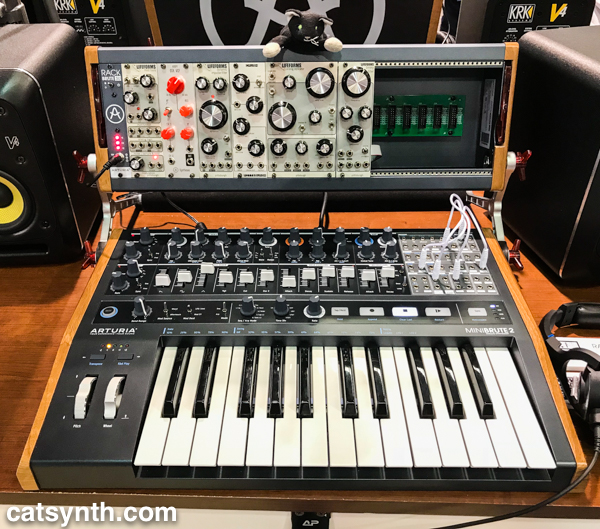
The original MiniBrute made quite a splash a few years ago with its all-analog signal path, usability, and low price. It also had a sound that was distinct from other low-cost analog synths, in part because of the “Brute Factor” knob. That knob is back in the MiniBrute 2 along with a Steiner-Parker filter that together with the Brute oscillator gives the instrument its sound. But there is now a second oscillator, and, perhaps more significantly, a modulation matrix and patch bay.
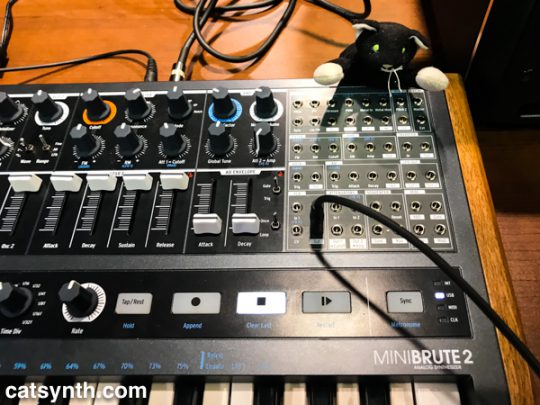
The built-in synthesizer topology includes a lot more modulation than the original, and the patch bay allows for reconfiguration and expansion with the RackBrute Eurorack cases that integrate 3U or 6U or modules with the MiniBrute in a single case. This does seem to be a trend we are seeing with built-in patch bays to full analog mono synths (the Moog Mother-32 being the prime example). One can also interpret the MiniBrute 2 as incorporating ideas from the flagship MatrixBrute writ small. The ecosystem also includes an alternate form-factor, the 2S, which has drum pads reminiscent of the BeatStep Pro instead of the keyboard.
We were only able to scratch the surface at NAMM, and also had a bit of difficulty with our video. So we are hoping to provide a more in-depth look at this instrument both here and on CatSynth TV in the not too distant future.
We continue to work our way slowly through the embarrassment of riches from NAMM 2018 with a look at new modules from Erica Synths.
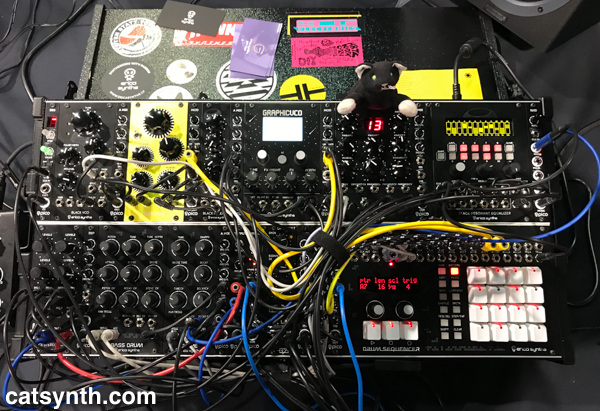
The biggest of the new modules, both physically and in terms of garnered attention, was the Drum Sequencer module. It has an attractive retro look and feel with a raised keypad and red LED display, reminiscent of instruments and studio gear from the 1980s. It also features 12 independent trigger outputs and 12 separate accent outputs – of course in the context of a modular synth one need not use the accent outputs for “accents”.

The sequencer itself is full-featured with separate meter and length per track as well as independent shuffle and probability per step. The probabilistic step function is intriguing, and one I did not have a proper opportunity to explore at NAMM, so hopefully I will get a chance to do so in the not too distant future.
The Graphic VCO returns to a more contemporary design found in many digital Eurorack modules.
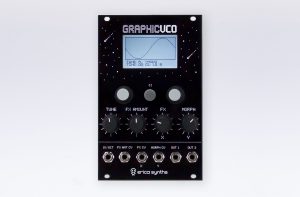
This module allows the user to draw his or her own waveforms Etch-a-sketch style to use in two simultaneous wavetable oscillators. In addition to mixing, they can be arranged in different topologies for FM, ring modulation, waveshaping and more. The waveform selections and configurations can be sequenced for continuously morphing sounds. It would be interesting to use with the Drum Sequencer.
The final module we looked at was the Resonant Equalizer. It is basically a 12-band bandpass filter with each band independently controllable via CV. One can also control all the bands with a single CV input for sequencer-based changes. Again, this feels like a module that would work well in tandem with the Drum Sequencer. It also has an attractive visual look for live performance use.

You can see all these modules in action in our recent video, which also features a “virtual appearance” by Tuna, the official Erica Synths cat 😺
We congratulate Tuna and rest of the team from Erica Synths on their offerings for this year’s show, and hope to someday visit them in Latvia.
For more information, please visit http://www.ericasynths.lv/
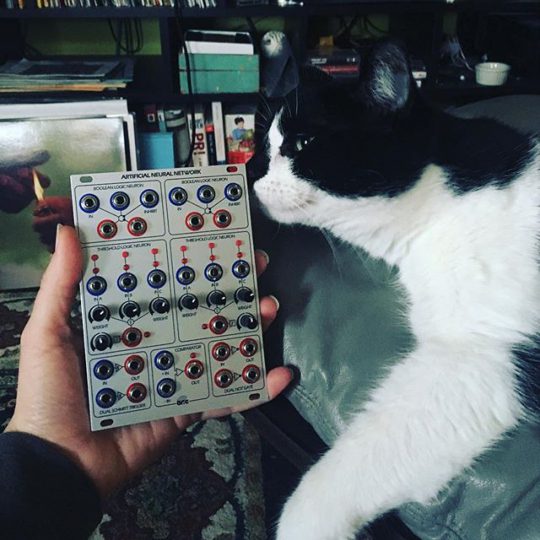
Monkey the tuxedo cat checks out an Artificial Neural Network module from Analog Research (ARC). By @synthlibrary (the S1 Synth Library) on Instagram.
Here is Monkey with one of our new modules from @arcmodular! We’re so excited to explore these new synths. #funweek#thanks#feelinglucky#neuralnetwork#eurorack#catsynth
This module captures both the look and spirit of Serge synthesizer modules with its simple function and logic blocks. You can find out more here.
We are always on the lookout for something (or someone) different at NAMM, especially in the deep dark depth of Hall E. This year we found it in the booth of Yudo, a company out of Japan that presented prototypes for two radically different concepts.
The flagship Neuman synthesizer features a standard keyboard with an instrument-spanning touch screen. It looks like an iPad stretched out to fit a full-sized keyboard.
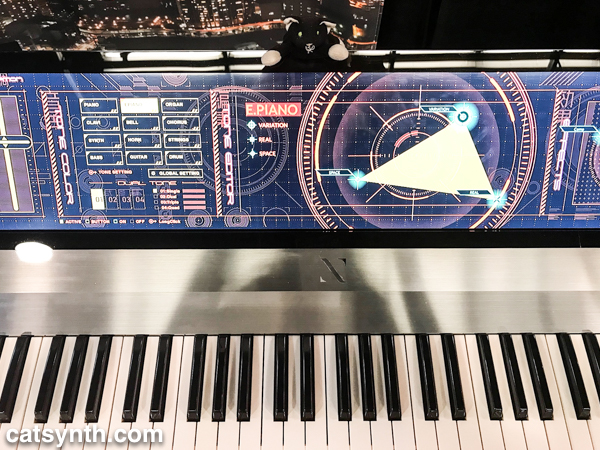
The keyboard plays well, and there were standard sounds such as electric pianos, brass, etc. The touchscreen controls for the patches were fascinating, but not particularly intuitive. It was hard to see using it for sound design in its current incarnation. But it is a prototype with an estimated two years or more of development ahead, so we will see where things go.
At the opposite end of the spectrum is the KAMI-OTO, a small cardboard based keyboard controller to use with iPads. It is a simple cardboard cutout that folds around a simple electronic main board and includes a stand for your tablet. There are wired and Bluetooth models that go for $28 and $36, respectively via the company’s Kickstarter campaign.
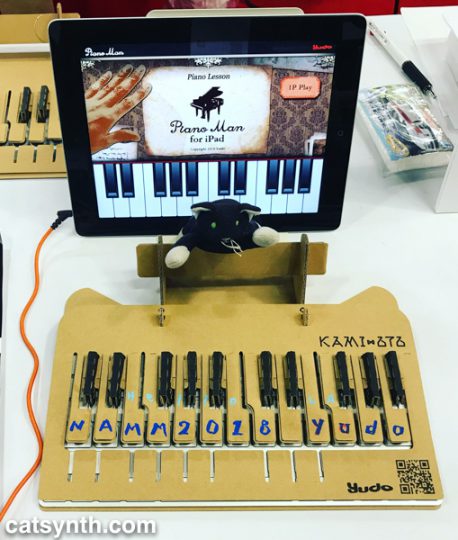
We did have a chance to try it out. It is adorable, and it does look like a fun and simple DIY project to assemble. And there is some delight in being able to decorate it in whatever manner one desires. As a keyboard, however, the latency was extremely high, which would render it less than usable for us in a performance setting. Nonetheless, for composing on the run, it could come in handy.
More info about both products can be found at https://www.yudo.jp/en/.
It’s been a slow recovery from our latest bout of this year’s influenza and “NAMMthrax,” but we are getting there slowly. Indeed, I have been well enough to spend more time working in the studio again. Of course, if I am in the studio there is a good chance Sam Sam will be there, too.

It’s always a delight to have her around. I think she is getting used to all the weird electronic sounds just as Luna did. As a more social cat, I think she mostly just enjoys being near the action. I do sometimes feel guilty when she gets comfy under the main console and I want to use the Nord. It’s a studio musician’s version of the cat-in-lap dilemma.
We are going to move forward with some video and music work today, as body and energy permit. We are also doing our part for today’s mass ritual here in the United States with our Superb Owl.

We hope you all have an enjoyable day, however you chose to fill it!